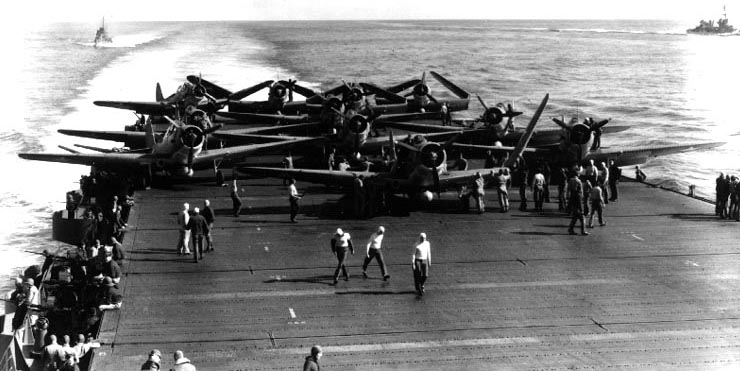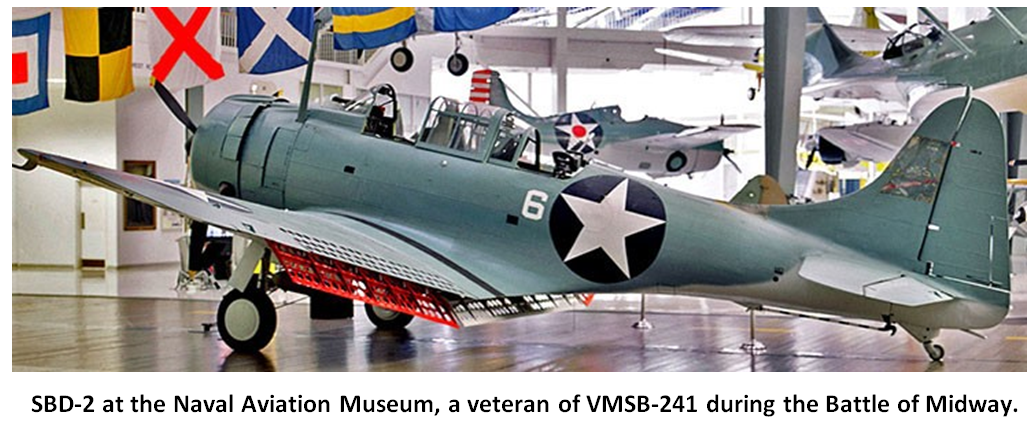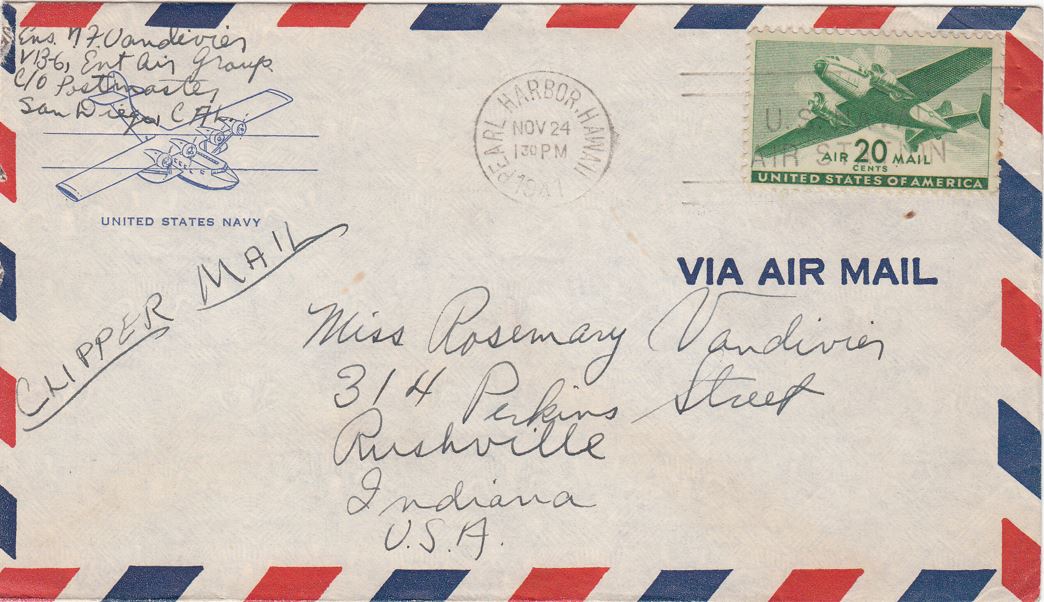Roundtable Forum
Our 25th Year
February 2022
In this issue.
Roundtable Opening Remarks
Admiral Wilson Brown and The Battle of Midway
Caught on Flim: Dick Best's Dauntless
Who Really Wrote the Hornet's After-Action Report?
More About the Battle of Midway at NHHC
On Film: The Last Combat Flight of the TBD Devastator
Now Hear This
|
The Battle of Midway Roundtable Opening Remarks

Welcome to the February issue of The Battle of Midway Roundtable. This month we have a really interesting follow up to the photo of Dick Best's Dauntless landing on the Enterprise, a note on the After Action Report Captain Mitscher filed after the battle and a bit of trivia about the Last Combat Flight of the TBD Devastator.
The submission that interested me the most was about Admiral Wilson Brown and the overland attack on Lae and Salamaua on March 10th, 1942. Briefly Rear Admiral Fletcher in command of the Yorktown group and Vice Admiral Brown and Captain Sherman with the Lexington group were discussing a plan to attack the landings. However to close within range to attack the landings taking place on the northern coast of New Guinea the force would have to approach through the Bismark Sea and so would be within range of the Japanese airbase at Rabaul. It was decided instead to launch the attacks from the south of New Guinea flying overland. However the Owen Stanley mountain range ran the length of New Guinea and rose to heights of 16,000 feet. The only way the heavily laden TBD Devastators could make the trip would be a 7,500 foot pass between Mt. Stanley and Mt. Lawson and there was no certainty they could make that.
The attack was unique in another way. Pre-war doctrine had carrier task forces operating independently, not together. In order to maximize surprise and maximum damage Fletcher and Brown decided to operate together. They launched about 150 miles from the target in the Gulf of Pagua, Lexington first, and Yorktown a few minutes later. Altogether they sent 104 planes, 61 SBDs, 25 TBDs, and 18 Wildcats as cover. The TBDs were armed with a mix of torpedoes and bombs, 13 Lexington TBD's carried torpedoes and 12 Yorktown TBDs were armed with bombs. The Lexington TBDs arrived first and attacked the anchored transports claiming three hits. The rest of the attack force arrived shortly and proceeded to attack the ships still present in the area.
The Japanese cruiser Yubari was damaged as were two destroyer, a minelayer, tender, two minesweepers, and a large transport. Sunk was an Army transport and a Navy transport. The attack force suffered one SBD lost and several SBDs and TBDs damaged, none seriously. The attack was considered a moderate success for the two US carriers but an embarrassment for the Japanese leading directly to the demand for air cover for any future landings on New Guinea.
However there was one other lesson learned from the battle that was far more significant. Captain Elliot Buckmaster in command of the Yorktown was disappointed in the number of ships damaged rather than sunk as both the TBDs and SBDs pressed home their attacks as evident by the rifle fire damage to some returning aircraft. In his after action report he blamed the modest results due to the use of instantaneous fuses on the bombs that exploded on contact with the ship rather using delayed action fuses which would penetrate the deck before exploding. He wrote "It is considered that the use of delayed action fuses is essential against surface vessels. The advantage to be gained by fragments of near misses is far outweighed by the disruptive internal damage when a direct hit is obtained"
Later in The Battle of Coral Sea Shokaku would suffer significant damage due to the delayed action fuses that kept Shokaku from participating in the upcoming operation MI. Zuikaku, although undamaged, also missed operation MI, due to losing a significant number of aircraft that were pushed overboard when she had to recover both her own returning aircraft and the returning Shokaku aircraft as well. A month later Japan lost four carriers from delayed action fuses detonating in the hangar deck.
ADMIRAL WILSON BROWN AND THE BATTLE OF MIDWAY
[Ed. note: you’re probably familiar with my frequent observation that the BOM was like a string of dominoes all lined up and ready to fall: each one was vital to the outcome, and in its absence something else would have happened; probably something bad. Bill Jensen offers another domino for the string. —RR]
_________________________
1 Feb 2022
From: Bill Jensen
Colorado
I think Admiral Wilson Brown, Jr. deserves some attention for setting the stage for the USN success at Midway.
His brilliant attack on 10 March 1942 in New Guinea has no equal. The first time two flattops operated together included flying combined strike packages over 100 miles of jungle and managing underperforming Devastators over a 10,000 ft mountain range. No war planner ever imagined carriers would make battle and bring destruction like this.
Here's the good part. The Japanese would face a lingering suspicion: Pearl Harbor was an absolute failure! Notwithstanding American shipyards building a mega-fleet, pre-war (fully fueled and supplied) USN flattops with escorts were willfully stopping critical Japanese expansion plans. These Japanese losses aren't acceptable if not shameful, thus their later scheduled Port Moresby operation was immediately reinforced with two fleet fast carriers from Kido Butai. Consequently, these two capital ships took a beating at the Battle of Coral Sea and did not appear at the Midway offensive operation. Their absence lent a strong hand towards the success of American forces. Imagine six IJN flattops at Midway!
So, I want to praise Admiral Brown for brilliance and initiative which strongly contributed to the American success at Midway!
_________________________
Re: CAUGHT ON FILM: DICK BEST’S DAUNTLESS
(See the January issue)
_________________________
31 Jan 2022
From: Jim Maas
New York
I was flabbergasted by the article about the VB-6 and VS-6 landing gear colors. I had never heard of it before, but recognized it immediately. It was the same color coding system used on pre-war Navy aircraft, just a lot less flamboyant. Here, pilfered from the Internet, is a graphic of the pre-war system used during the 'Yellow-Wing' era, where a quick glance at the cowl front told you the plane section and number within a squadron.
http://www.pmcn.de/English/USN%20Markings%20I/USN%20Markings%20I.htm
_________________________
1 Feb 2022
From: Paul Faulkner
New York
I found the above referenced article fascinating, as I had never heard of the landing struts being painted in such a manner. It begs the question, were VF-6 and VT-6 aircraft similarly color-coded? Was this practice continued later in the war, or on any other carriers, or was it unique to USS Enterprise and the Midway battle?
Thank you for any further insight you can offer on this subject.
_________________________
2 Feb 2022
From: Chris Hawkinson, Jr.
Wisconsin
Looking at the document Kent Walters shared from Dick Best regarding VB-6 and VS-6's landing gear strut colors in the January 2022 issue, the colors used on the landing gears seemed familiar to me, but I couldn't place it. I was then paging through some pre-war TBD color profiles and I recognized the pattern: each section appears to use the same colors on their landing gear struts which were used during the high-visibility "yellow wings" in the 1930s USN.
The following information comes from Tracy White's excelled Research At Large web site. It is a great summary of pre-war USN aircraft markings, including this part detailing aircraft section markings and the colors to be used:
[Quote] The next revision took place in June of 1931, when 20" vertical bands on the fuselage of Section Leader aircraft were ordered. The color of each band was to denote the section of the squadron, and was to be repeated around the engine cowling. The number 2 plane of each section was to have this same color around the upper half of the cowling, and the number 3 plane was to have the same color on the bottom half of the cowling. The colors and section are listed in the table below: [Unquote]
http://www.researcheratlarge.com/Aircraft/YellowWings/index.html
[Ed. note: to see the table cited above, click this URL and scroll down to "1931 Revision." Then spend a little time examining the entire page; it’s fascinating!]
The pre-war section colors are a match for those used by VB-6 and VS-6 on their landing gear struts.
Given this link between pre-war section identification and Enterprise SBDs in 1942, I wonder if this was something exclusive to Enterprise SBDs or perhaps was used by other squadrons and/or other carriers as well. Also, there isn't any mention of how the CEAG's struts were painted. It might be time to give those period color photos a re-look. _________________________
WHO REALLY WROTE THE HORNET’S AFTER-ACTION REPORT?
[ Ed. note: previous analyses of The Flight to Nowhere have generally suggested, directly or by inference, that Captain Mitscher’s after-action report was a deliberate coverup on his part. But does he get all of the blame himself, or does most of it belong to staff work that he simply endorsed without sufficient thought and without fully appreciating what it said; something he was known for throughout his career? —RR]
_________________________
1 Feb 2022
From: Don Boyer
Hawaii
I haven't thoroughly read through all the material regarding the Flight to Nowhere and the subsequent Hornet battle report that apparently so mis-represents the case that it has often been called "falsified." Not sure if that term is entirely correct or not, but knowing the circumstances and the personality of the primary author, "very selectively written" might be more appropriate for all the obvious reasons.
One thing I am sure of is that Mitscher was well known to have a disdain for closely vetting "reports." He, like many others, detested "administrative paperwork" (admittedly a very bad habit) and this has been mentioned from several sources, including his later Chief of Staff, Captain Arleigh Burke. So, him signing off on a report that wasn't exactly correct would not be a surprise to me; the important point here being that he had no deliberate intent of "covering" for a subordinate. The battle was a massive victory, he was putting on rear admiral's stripes, let's get on with the war was probably the mantra of the day, not "let's nitpick every battle report looking for mistakes."
Mitscher could be as ruthless as the next in weeding out the incompetent, as his track record during the war indicates. The survival of Stanhope Ring in positions of authority and the lack of close scrutiny of his actions on that day do not surprise me at all, considering the man who "reviewed" the action report. Also, the fact that the report doesn't tell the truth doesn't surprise me -- it is quite clearly indicative of the moral compass of the man who wrote it and who was responsible for the actions of the Hornet Air Group that day.
Mitscher can take little if any blame for the content or intent of that particular battle report other than being "the guy who let it slide," in my opinion. He was not a villain, covering up mistakes because of fear of actions less than enhancing of his career, he was not that type of naval officer.
_________________________
MORE ABOUT THE BATTLE OF MIDWAY AT NHHC
There are a multitude of references about Midway available on the Naval History and Heritage Command website, with the Weisheit recordings featured in the December newsletter being a prime example. But here’s another one that’s definitely worth a look if you’ve never seen it: the “H-gram” series on the occasion of the 75th BOM anniversary in 2017.
H-grams are essays by the NHHC’s director on specific naval history subjects, with H-gram #006 covering the BOM. It is subdivided into six segments detailing the background and conduct of the battle plus a detailed look at a Marine SBD-2 that was restored for the Naval Aviation Museum at Pensacola.

The author of the series, NHHC Director Samuel Cox, provides an excellent synopsis of the battle that sticks closely to the facts as we now know them and is refreshingly free of opinion or conjecture. It’s highly recommended for anyone who might benefit from an accurate overview that can be digested in a few minutes.
Here’s the link for the Midway set, and after you’ve finished that one you might want to browse a few of the others; they’re all very well done. Number 007, on the subject of the USS Liberty incident in 1968 is one of the best treatments of that subject that you’re likely to find. Enjoy.
https://www.history.navy.mil/about-us/leadership/director/directors-corner/h-grams/h-gram-006.html
Re: ON FILM: THE LAST COMBAT FLIGHT OF THE TBD DEVASTATOR
(See the January issue)
_________________________
2 Feb 2022
From: Steve Kovacs
Michigan
The Roundtable Forum never fails to teach me something new each month and the January 2022 issue was no exception. Among other things, I learned in the last paragraph of, ‘On Film: The Last Combat Flight of the TBD Devastator’ that there has been confusion in the literature and in web references over the correct spelling of ENS Norman F. Vandivier’s last name. In order to forever settle the spelling mystery, please see the attached envelope from my collection. It was addressed by Vandivier in his own handwriting in November 1941 to his sister, while he was attached to VB-6, Enterprise Air Group. As author Ray Boomhower mentioned in the sidebar (refer to the link at the end of ‘Last Combat Flight’), the Vandivier family farm was located in Franklin, Indiana, just south of Indianapolis, while Rosemary resided not far east of Indianapolis in Rushville, Indiana, where she taught school.

For those who are interested, a catalog of the Vandivier Family Papers may be found at this link:
VANDIVIER FAMILY PAPERS, 1839-1961 (indianahistory.org)
Norman’s papers chiefly consist of letters that he wrote to his parents and his sister from 1939–42. Two of his letters may be viewed at:
Letter from Norman Vandivier to his Family, October 14 - WW II Materials - Indiana Historical Society Digital Images (indianahistory.org).
Although not available for Internet viewing, other surviving materials include “his reports, logs, maps, and related items he used as a carrier pilot,” along with his naval aviator certificate and a squadron photograph. A query to the Indiana Historical Society might enable access to these materials.
_________________________
Our third Midway Roundtable bulletin was sent to all members on February 15th. If you’re receiving our email announcement for the regular monthly newsletter (like this one) but not the bulletin, be sure to let us know. It’s likely that there are still some email issues out there that require resolution, and with your help we’ll get them all fixed.
* * * * * *
Speaking of the February bulletin, we had a couple reports that the link to Captain Mitscher’s USS Hornet after-action report on the Naval History and Heritage Command website was broken. After some testing, we noted that it indeed did fail on occasion using the Firefox browser, but seemed to work very reliably using both the Edge and Chrome browsers. If you have an experience like that with the cited NHHC page (or any other), trying an alternate browser might be your best option.
* * * * * *
Also, concerning the Hornet after-action report, we’re still hoping one of our members has the full report that can be shared with the Roundtable. The NHHC link only provides Captain Mitscher’s cover letter dated 13 June 1942, but the full report contains numerous enclosures with a lot of important content. It’s those enclosures that we’d very much like to recover. If anyone does have the entire report with enclosures “A” thru “I” or any portion thereof, please let us know, and sincere thanks in advance.
* * * * * *
That’s it for February, and as always, thanks to everyone for your continuing interest in our newsletters, the new bulletin, and the resources on our website. We’re always delighted to receive your messages, whether you have a brief comment, a probing question, or a significant composition on a BOM-related topic.
Best wishes to all,
—Thom Walla, editor and webmaster
—Ron Russell, contributing editor
|